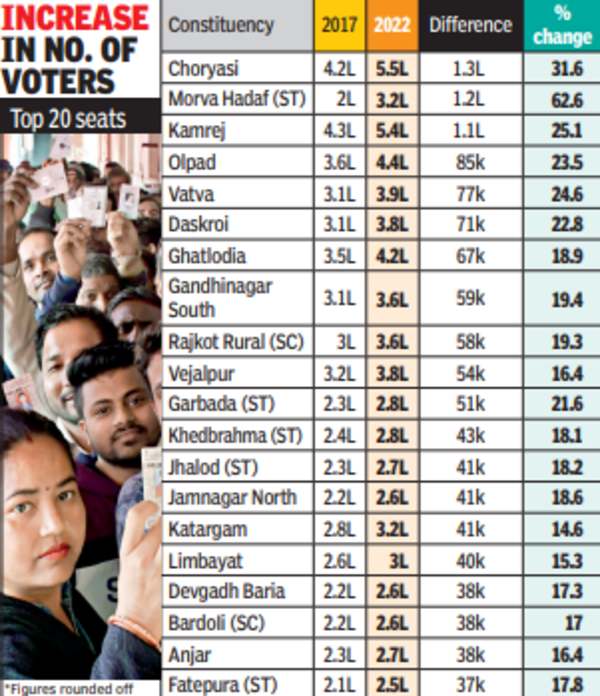All 182 constituencies have registered an increase in voter numbers in the range of 5,500 to 1.32 lakh. Choryasi leads with an increase of 1.32 lakh voters followed by Kamrej with 1.08 lakh.

Since the last assembly election, the electorate swelled by 49 lakhs or 11% – from 4.35 crore to 4.84 crore – according to the official figures.
However, a comparison of male and female voters revealed that six of the top 10 constituences that registered maximum increase in the voter sex ratio (number of women/1,000 men) were in Saurashtra. This indicated a pattern of migration of males from the region to the urban areas of the state. Junagadh constituency registered the maximum increase in voter sex ratio. Of the 2.85 lakh voters registered in 2022, 1.58 lakh are women, and 1.46 lakh are men.
About 2.6 lakh voters had registered in 2017; of these were 1.23 lakh women. Migration is seen as the major reason behind urban constituencies gaining voters; Surat is the biggest contributor to the trend as Saurashtra has seen mass movement of people to the diamond city.
The five constituencies which had a skewed sex ratio, where the number of women per 1,000 men were below 800, were from Surat district. These are Udhna (727 women), Karanj (742), Choryasi (756), Varachha Road (782) and Limbayat (792).
Significantly, the reverse migration of people — from urban areas to tribal-dominated rural areas of the state — is being perceived as the main reason behind maximum increase in voter numbers in the five constituencies reserved for STs over five years. According to the officials, a large number of migrant workers who returned to their home districts during the lockdown, have preferred not to go back to the cities for work.
Surat has the lion’s share of urban seats where the increase in voter numbers is steep. Six of the 12 urban seats with maximum increase in voter numbers are from Surat.
Choryasi – the outgrowth areas of Surat city fall in this constituency – has gained maximum voters in five years; from 4.16 lakh, the figure has now reached 5.49 lakh.
Surat collector and district election officer Ayush Oak said that migration of those belonging to the younger generation, below 40 years of age, is permanent. “Since their children are of schoolgoing age, they have houses here and get EPIC cards here. Choryasi and Kamrej are the two fast-growing outgrowth areas of Surat city,” said Oak who has served in districts of Saurashtra too.
Explaining the phenomenon of growth of voters in ST seats, Dahod collector Harshit Gosavi said that quality medical and educational infrastructure, and enough employment opportunities, have led to tribal voters preferring to stay back in their home districts. P S Biawal, sarpanch of Vadva village in Dahod district, said that a trend of reverse migration is observed in several villages of the district after the pandemic. “A majority of the workers, who used to go to the cities earlier to find work, are no longer doing so after the pandemic,” he said.





